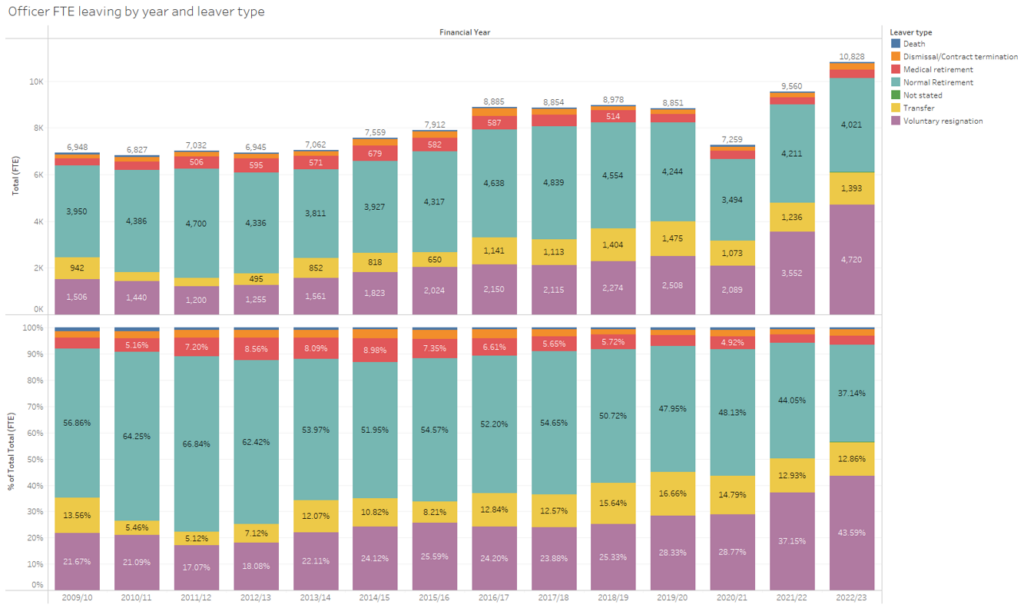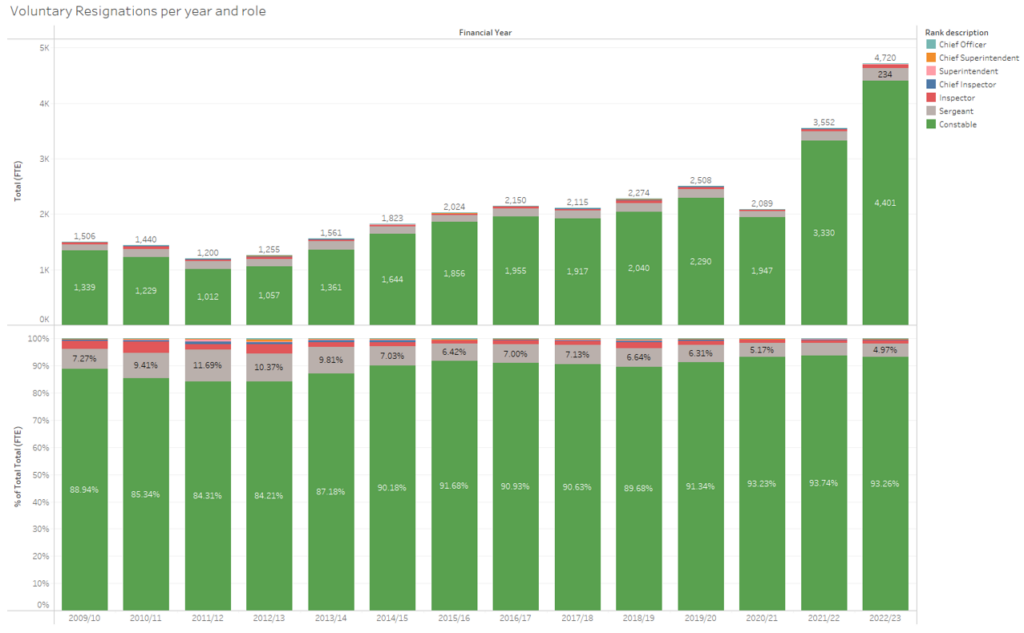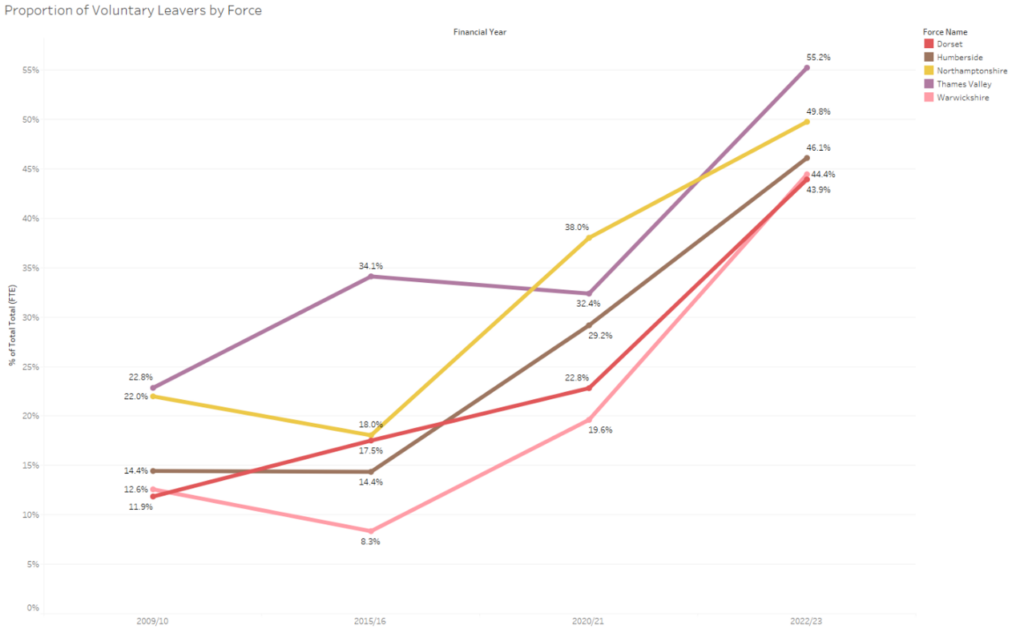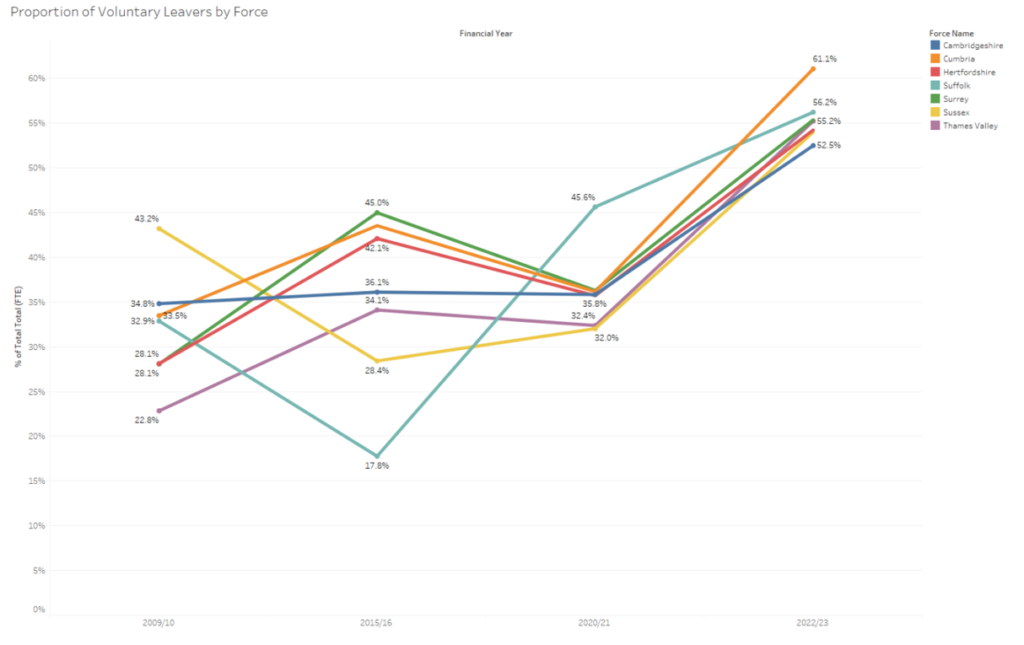;)
Life after COVID
Whilst the pandemic was at its peak, national low levels of job movement were observed; with companies reducing in size and a shallow job market, the ‘risk’ of moving jobs seemed to be too high a price for many within the country. Policing however, with its specific training and workstyle could be presumed to be unaffected by the ‘Post Pandemic Shuffle’, but has that been true?
Leaving sooner rather than later?
The common adage is whether Policing is still a ‘career for life’, and for some this may still be true. Different factors however can all affect how any given individual will perceive a career; whether there is enough fiscal value, the interpretation of the role and a number of other factors. The figure below shows the number of leavers, and the proportionate percentage of the leaving reasons on a national scale below, from 2009/10 through to 2022/23.

Whilst a blip is observed in the total FTE of officers leaving at the height of the pandemic in financial year 2020/21, the rate of leavers continues to increase and almost step-change into 22/23. This can largely be attributed to the number of Voluntary Resignations seen across these years, with the number of Voluntary Resignations climbing from 1,200 in 2011/12 to 4,720 in 22/23 (an increase of 3,520 in total and a proportionate growth within all resignations of 26.52%) and becoming the leading cause of leavers as of the past financial year.
What’s also worth noting is that, whilst the proportion of the normal retirement banding is reducing, the total numbers of those type of leavers has stayed relatively consisting, typically within 500 of their previous year, so what roles are making this increase in voluntary resignations?

The main driver of voluntary resignations has always been the constable role, and over the course of the recorded time period, with the exception of a drop from 2009/10 to 11/12, has served mostly to increase within this role. For the past 3 financial years, Constable contributed to over 93% of the FTE lost through voluntary resignation.
A large portion of those recent resignations could be attributed to the officer uplift, metrics from the Home Office saw a number of fluctuations in their force by force ‘Uplift Totals’ prior to their final goal of 20,000. But stress could also play as a factor, the number of Sergeants handing in voluntary resignation, despite that low proportionate percentage are also increasing in number. With 234.5 FTE worth of this role resigning in the last financial year.

Our work with police forces across the country have consistently cited the supervisory ratios and their struggle with meeting the job requirements. This isn’t due to their competency, but the sheer amount of work to complete at their current supervision numbers. Could this also be having a rolling effect on those higher ranks?
So is Policing still a career for life?
The initial findings would suggest not so, based on sheer numbers of people leaving. But on a force by force basis, these proportions are also changing.

Of the 44 forces observed within Home Office data, 22 of them have seen their voluntary resignation proportions more than double from their amount in 2010. Five of the highest seen within this set belong to Thames Valley, Dorset, Warwickshire, Humberside & Northamptonshire. Interestingly, this is a mix of force sizes and scape in lieu of perhaps say a collective of large establishment and strength city-based forces.

The seven forces above have now all breached the threshold of having more than half of their resignations being attributed to the voluntary category. Thames Valley again features, though judgement could link this to a higher intake of Uplift recruitment again than their initial allocation. All of these forces recruited more than their respective uplift allocations, though not to the same margins.
Conclusion
The numbers of those leaving the police have reached new heights, and whilst this fact is somewhat scuppered by recent record numbers of officers in employment, that picture may not be sustainable.
This isn’t due to people taking retirement, nor is it due to an increase in medical retirements or tightening of the budget. It’s now due to people voluntarily leaving their officer roles behind. Nationally we’ve seen just under half of all resignations this past year be attributed to voluntary resignations, 58% if you choose to include transfers.
Police forces have to start looking internally to understand the leaking that is happening within their ranks. Having a good understanding of their workforce, are they leaving from teams under pressure? Are sergeants with high supervisory ratios resigning from the job? Are new Uplift related recruits being put into too much, too soon? Effective workforce planning is needed to, in the first instance, understand what can stem the flow. Failing this however, recruitment needs to remain high or effective allocation of resources is imperative to sustain an acceptable amount of investigative capability.
By Matt Gill – Analytical Consultant